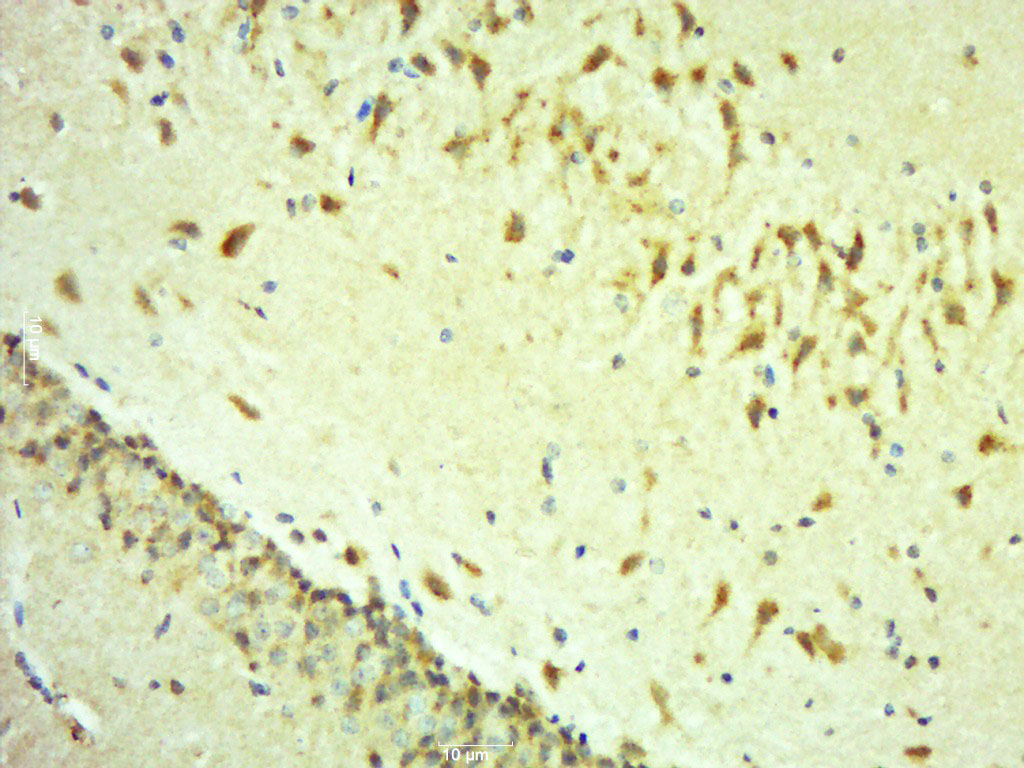MMP2 antibody
GTX104577
ApplicationsImmunoFluorescence, ImmunoPrecipitation, Western Blot, ImmunoCytoChemistry, ImmunoHistoChemistry, ImmunoHistoChemistry Frozen, ImmunoHistoChemistry Paraffin
Product group Antibodies
TargetMMP2
Overview
- SupplierGeneTex
- Product NameMMP2 antibody
- Delivery Days Customer9
- Application Supplier NoteWB: 1:500-1:3000. ICC/IF: 1:100-1:1000. IHC-P: 1:100-1:1000. IP: 1:100-1:500. *Optimal dilutions/concentrations should be determined by the researcher.Not tested in other applications.
- ApplicationsImmunoFluorescence, ImmunoPrecipitation, Western Blot, ImmunoCytoChemistry, ImmunoHistoChemistry, ImmunoHistoChemistry Frozen, ImmunoHistoChemistry Paraffin
- CertificationResearch Use Only
- ClonalityPolyclonal
- Concentration0.33 mg/ml
- ConjugateUnconjugated
- Gene ID4313
- Target nameMMP2
- Target descriptionmatrix metallopeptidase 2
- Target synonymsCLG4, CLG4A, MMP-2, MMP-II, MONA, TBE-1, 72 kDa type IV collagenase, collagenase type IV-A, matrix metallopeptidase 2 (gelatinase A, 72kDa gelatinase, 72kDa type IV collagenase), matrix metalloproteinase-2, matrix metalloproteinase-II, neutrophil gelatinase
- HostRabbit
- IsotypeIgG
- Protein IDP08253
- Protein Name72 kDa type IV collagenase
- Scientific DescriptionProteins of the matrix metalloproteinase (MMP) family are involved in the breakdown of extracellular matrix in normal physiological processes, such as embryonic development, reproduction, and tissue remodeling, as well as in disease processes, such as arthritis and metastasis. Most MMPs are secreted as inactive proproteins which are activated when cleaved by extracellular proteinases. This gene encodes an enzyme which degrades type IV collagen, the major structural component of basement membranes. The enzyme plays a role in endometrial menstrual breakdown, regulation of vascularization and the inflammatory response. Mutations in this gene have been associated with Winchester syndrome and Nodulosis-Arthropathy-Osteolysis (NAO) syndrome. Two transcript variants encoding different isoforms have been found for this gene. [provided by RefSeq]
- Storage Instruction-20°C or -80°C,2°C to 8°C
- UNSPSC12352203
References
- Su CC, Yu CC, Shih YW, et al. Protective Effect of Alpha-Linolenic Acid on Human Oral Squamous Cell Carcinoma Metastasis and Apoptotic Cell Death. Nutrients. 2023,15(23). doi: 10.3390/nu15234992Read this paper
- Wang CW, Chiou HC, Chen SC, et al. Arsenic exposure and lung fibrotic changes-evidence from a longitudinal cohort study and experimental models. Front Immunol. 2023,14:1225348. doi: 10.3389/fimmu.2023.1225348Read this paper
- Hung TH, Huang Y, Yeh CT, et al. High expression of embryonic stem cell marker SSEA3 confers poor prognosis and promotes epithelial mesenchymal transition in hepatocellular carcinoma. Biomed J. 2024,47(2):100612. doi: 10.1016/j.bj.2023.100612Read this paper
- Belhoul-Fakir H, Wu J, Yeow YL, et al. Injury to the tunica media initiates atherogenesis in the presence of hyperlipidemia. Front Cardiovasc Med. 2023,10:1152124. doi: 10.3389/fcvm.2023.1152124Read this paper
- Chang TM, Chiang YC, Lee CW, et al. CXCL14 promotes metastasis of non-small cell lung cancer through ACKR2-depended signaling pathway. Int J Biol Sci. 2023,19(5):1455-1470. doi: 10.7150/ijbs.79438Read this paper
- Hsu PL, Chien CW, Tang YA, et al. Targeting BRD3 eradicates nuclear TYRO3-induced colorectal cancer metastasis. Sci Adv. 2023,9(15):eade3422. doi: 10.1126/sciadv.ade3422Read this paper
- Hsiao YC, Wang IH, Yang TL. Fibrotic remodeling and tissue regeneration mechanisms define the therapeutic potential of human muscular progenitors. Bioeng Transl Med. 2023,8(2):e10439. doi: 10.1002/btm2.10439Read this paper
- Guo Y, Chomiak AA, Hong Y, et al. Histone H2A ubiquitination resulting from Brap loss of function connects multiple aging hallmarks and accelerates neurodegeneration. iScience. 2022,25(7):104519. doi: 10.1016/j.isci.2022.104519Read this paper
- Chen HC, Chiou HC, Tsai ML, et al. Effects of Montelukast on Arsenic-Induced Epithelial-Mesenchymal Transition and the Role of Reactive Oxygen Species Production in Human Bronchial Epithelial Cells. Front Pharmacol. 2022,13:877125. doi: 10.3389/fphar.2022.877125Read this paper
- Zhang MH, Liu J. Cleavage stimulation factor 2 promotes malignant progression of liver hepatocellular carcinoma by activating phosphatidylinositol 3'-kinase/protein kinase B/mammalian target of rapamycin pathway. Bioengineered. 2022,13(4):10047-10060. doi: 10.1080/21655979.2022.2063100Read this paper





![WB analysis of 25 microg of the indicated whole cell lysates using GTX15772 MMP2 antibody [F14 P4 D3]. Dilution : 5 microg/ml](https://www.genetex.com/upload/website/prouct_img/normal/GTX15772/GTX15772_1527_WB_w_23060620_320.webp)
![IHC-P analysis of human breast tissue using GTX15773 MMP2 antibody [MMP2/2C1-1D12]. Right : Primary antibody Left : Negative control without primary antibody Antigen retrieval : 10mM sodium citrate (pH 6.0), microwaved for 8-15 min Dilution : 1:20](https://www.genetex.com/upload/website/prouct_img/normal/GTX15773/GTX15773_1036_IHC-P_w_23060620_710.webp)